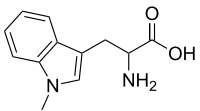1-Methyltryptophan
 | |
| Names | |
|---|---|
| IUPAC name
2-Amino-3-(1-methyl-1H-indol-3-yl)propanoic acid | |
| Other names
1-Methyl-DL-tryptophan; DL-1-Methyltryptophan; ARBRIN | |
| Identifiers | |
| |
| 3D model (JSmol) |
|
| ChemSpider | |
| ECHA InfoCard | 100.043.765 |
| PubChem CID |
|
| |
| |
| Properties | |
| C12H14N2O2 | |
| Molar mass | 218.26 g·mol−1 |
| Except where otherwise noted, data are given for materials in their standard state (at 25 °C [77 °F], 100 kPa). | |
| | |
| Infobox references | |
1-Methyltryptophan is a chemical compound that is an inhibitor of the tryptophan catabolic enzyme indoleamine 2,3-dioxygenase (IDO or INDO EC 1.13.11.52).[1] It is a chiral compound that can exist as both D- and L-isomers. The L-isomer (L-1MT) inhibits IDO weakly but also serves as an enzyme substrate. The D-isomer (D-1MT) does not inhibit IDO at all, but it can inhibit the IDO-related enzyme IDO2[2] and restore mTOR signaling in cells starved of tryptophan due to IDO activity.[3] D-1MT is also known as indoximod and is currently in clinical trials for cancer treatment.
References
- ↑ Cady, SG; Sono, M (1991). "1-Methyl-DL-tryptophan, beta-(3-benzofuranyl)-DL-alanine (the oxygen analog of tryptophan), and beta-3-benzo(b)thienyl-DL-alanine (the sulfur analog of tryptophan) are competitive inhibitors for indoleamine 2,3-dioxygenase". Archives of Biochemistry and Biophysics. 291 (2): 326–33. PMID 1952947. doi:10.1016/0003-9861(91)90142-6.
- ↑ Metz, R; Duhadaway, J. B.; Kamasani, U; Laury-Kleintop, L; Muller, A. J.; Prendergast, G. C. (2007). "Novel tryptophan catabolic enzyme IDO2 is the preferred biochemical target of the antitumor indoleamine 2,3-dioxygenase inhibitory compound D-1-methyl-tryptophan". Cancer Research. 67 (15): 7082–7. PMID 17671174. doi:10.1158/0008-5472.CAN-07-1872.
- ↑ Metz, R; Rust, S; Duhadaway, J. B.; Mautino, M. R.; Munn, D. H.; Vahanian, N. N.; Link, C. J.; Prendergast, G. C. (2012). "IDO inhibits a tryptophan sufficiency signal that stimulates mTOR: A novel IDO effector pathway targeted by D-1-methyl-tryptophan". OncoImmunology. 1 (9): 1460–1468. PMC 3525601
 . PMID 23264892. doi:10.4161/onci.21716.
. PMID 23264892. doi:10.4161/onci.21716.
This article is issued from
Wikipedia.
The text is licensed under Creative Commons - Attribution - Sharealike.
Additional terms may apply for the media files.